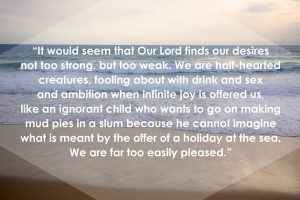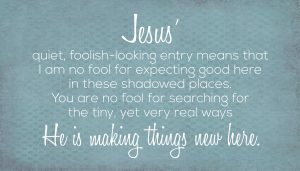Drowning Doesn’t Always Look Like Drowning
For the months of February through April we’ve invited several people to give you a peek into
the new directions God has called The Barnabas Center. We hope these directions will be
encouraging and that you’ll resonate with the needs and hopes that are being shared.
In May we’ll be back online with our usual thematic blog posts.
————————————————————————————-———————-
 It’s a horrible scene – someone having ventured into water too deep and current too strong – the human body facing forces that it can’t overcome. Drowning is the fifth
It’s a horrible scene – someone having ventured into water too deep and current too strong – the human body facing forces that it can’t overcome. Drowning is the fifth
leading cause of unintentional deaths in America. Arms
thrashing in water, legs kicking frantically, and panicked
cries for help are the telltale signs.
Only they’re not.
.
In reality, most of us wouldn’t know that a person was in trouble unless we were looking for the signs. People who are in serious danger of drowning don’t splash and kick – rather, the innate response is to hold arms straight out and press down on the water for buoyancy. They rarely have the luxury of calling out for help – whatever air their lungs may contain can’t be squandered. All of the victim’s resources are employed for the sole purpose of survival.
Everyday, we live life with people who are drowning. In loneliness, addiction and pain. In fear, disappointment, and regret.
I’ve been there. The world was closing in, and I didn’t have the energy to move toward rescue or signal for help. The survival instinct took over. All emotional and mental resources were needed just to make it through the day. There were no reserves from which to draw. From the outside, everything looked normal. It had to.
Until someone asked the second question. The one that comes after “How are you?”. The one asked by a friend who knows the signs of struggle, and who is willing to dive into risky waters and extend a lifeline.
Drowning doesn’t look like drowning. At least not what most of us picture. In reality, drowning looks like a friend, neighbor, or co-worker having a typical day. It may even look like success, busyness, and an idyllic family life. It often sounds like, “I’m fine. And how are you?”. From the outside, everything can look normal.
So how can we learn to tell the difference?
By slowing down. By letting go of assumptions. By being trained to look for the warning signs and by being willing to dive into troubled waters.
I multi-task my way through most days. It’s not unusual for me to grocery shop, return phone calls, respond to chattering children, and schedule meetings, all while thinking through the composition of my next article (for which the deadline is the following day). The neurons in both my left and right brain are competing for air-time, and their battle often results in gridlock. There’s not much mental or emotional excess capacity. Not for me, my family, or for anyone in need who may cross my path.
But despite the scheduled realities of life, I want to be available to those who are hurting. I have a list of to-dos for my day, yet I can choose to hold that list lightly. I have a plan but am acutely aware that there is One who holds the ultimate agenda. So rather than plow through the interruptions that threaten my progress, I want to live in expectancy of a shifting itinerary. To be flexible. To live humbly. To notice the slight shadow of unspoken hurt in the eyes of a friend who I just happen to see while I’m busily running errands.
Folks are drowning all around us. But if we’re willing to learn the signs, to slow down and ask the “next” question, and to hold our agendas lightly, we may be given the great privilege of witnessing a miracle.
And for those who’ve survived the torrents of life – well, you are uniquely qualified to help others.
To look beneath the smile.
To be curious and safe.
To offer the same lifeline of Hope that you cling to, the lifeline sustained by the Great Rescuer Himself.
——————————————————————————————————–
For the past three years, I’ve had the opportunity to participate in the strategic planning for The Barnabas Center. At the heart of the ministry is the desire to equip folks like me – and like you – to use our ongoing stories of struggle and rescue in order to offer hope to others. Barnabas is hard at work developing teaching and training tools that will equip us to be better friends, parents, spouses, co-workers, and neighbors. To learn more about Vision 2020, receive updates on the ministry, and become a part of the community, visit here.
“Praise be to the God and Father of our Lord Jesus Christ, the Father of compassion and the God of all comfort, who comforts us in all our troubles, so that we can comfort those in any trouble with the comfort we ourselves receive from God. For just as we share abundantly in the sufferings of Christ, so also our comfort abounds through Christ.”
2 Cor 1:3-4
.
To learn more about the Vision 2020 campaign please watch this brief video:
.
 Julie Silander received her BS degree in Business Administration from Furman University, and she held a variety of roles in the banking industry before becoming a full-time mom. Julie and David have five children, and they have been friends of Barnabas for close to twenty years. Most recently, Julie has been intimately involved in the strategic planning for The Barnabas Center in preparation for the next phase of the ministry. She spends the bulk of her days schooling their three youngest children. She also writes regularly at www.greenertrees.net and is a contributor to Story Warren.
Julie Silander received her BS degree in Business Administration from Furman University, and she held a variety of roles in the banking industry before becoming a full-time mom. Julie and David have five children, and they have been friends of Barnabas for close to twenty years. Most recently, Julie has been intimately involved in the strategic planning for The Barnabas Center in preparation for the next phase of the ministry. She spends the bulk of her days schooling their three youngest children. She also writes regularly at www.greenertrees.net and is a contributor to Story Warren.






